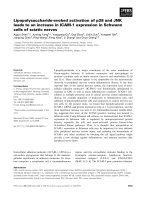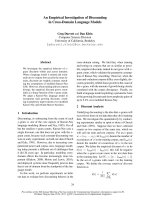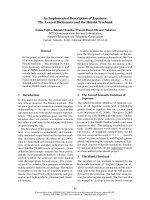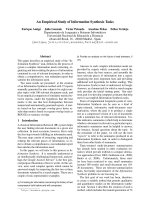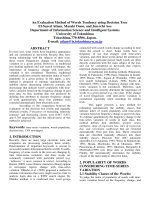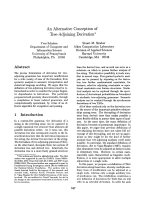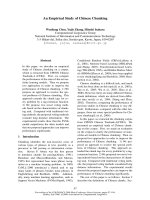Báo cáo khoa học: "an experimental study of ambiguity and context" ppt
Bạn đang xem bản rút gọn của tài liệu. Xem và tải ngay bản đầy đủ của tài liệu tại đây (174.22 KB, 8 trang )
[
Mechanical Translation
, vol.2 no.2, November 1955; pp.39-46]
a
n experimental study of ambiguity and context*
Abraham Kaplan, Department of Philosophy, University of California, Los Angeles
Ambiguity is the common cold of the pathology
of language. The logician recognizes equivoca-
tion as a frequent source of fallacious reason-
ing. The student of propaganda and public opin-
ion sees in ambiguity an enormous obstacle to
successful communication. Even the sciences
are not altogether free of verbalistic disputes
that turn on confused multiple meanings of key
terms.
Special importance attaches to ambiguity as a
result of the growing interest in the possibili-
ties of mass translation: rapid and routine
translation of large bodies of material. The
simplest expedient, as a first approximation,
is word by word translation — a word for word
substitution carried out by essentially clerical
methods, very possibly by machine. But word
for word substitution is hardly usable when the
words of both languages are even moderately
ambiguous.
It is a familiar fact that ambiguity of isolated
words is reduced by the contexts of their occur-
rence. The total behavioral situation in which
language functions is decisive in determining
what will be communicated. For many pro-
blems, however, (and in particular, that of
mass translation), the behavioral situation is
not accessible. The 'context' (itself an ambi-
guous word) must here be taken to consist of
the verbal setting in which the word to be in-
terpreted occurs, i.e., the other words with
which it is being used.
The problem of this study is to determine to
what extent and in what ways verbal setting re-
duces ambiguity. Is ambiguity primarily a
feature of words in isolation, or does it per-
sist to some extent even in context? What part
of the context is most effective in reducing am-
biguity — for instance, how is the ambiguity of
a selected word affected by the words imme-
diately preceding and following it, as compared
with the effect of the entire sentence in which
it occurs? Does it matter whether the imme-
diate context consists solely of particles ? How
is the reduction in ambiguity affected by the
linguistic sensitivity of the translator? By the
multiplicity of senses of the isolated word? By
the clarity of the word; that is, the ease with
which its multiple senses are identified? These
are the questions to which this study is ad-
dressed.
*Reprinted with permission of the Rand Corporation from
their report P18, dated November 30, 1950, which has been
out of print for several years.
39
Two important restrictions on this study are to
be noted.
In the first place, it deals with ambiguity of
single words, not homonyms (word types, not
word tokens
1
): the four letters "blow" actually
may constitute a single word, semantically and
grammatically speaking, or may be one of sev-
eral homonyms — a) to send forth a current of
air, b) a wind or gale, c) a blossoming or
blooming, or d) a forcible act or effort. There
is no doubt that the setting usually allows us to
distinguish nouns from verbs, for example,
hence among homonyms which are different
parts of speech. The problem here will be to
distinguish the multiple senses of a single word.
For instance, the verb "blow" has several
senses: a) producing a noise by blowing, b)
panting or puffing, c) talking loudly or boast-
fully, and so on. These are related senses, and
as a group quite distinct from the senses of the
homonym "blow" which means "to blossom."
The ambiguity with which this study is con-
cerned is thus more subtle than homonymy.
Whatever analysis is to be given of the distinc-
tion between homonyms and single words, it is
reasonable to suppose that the effect of context
on homonym-ambiguity is more marked than
that of the single-word-ambiguity here dealt
with.
A second restriction on the study is this. It is
not concerned with what ambiguity actually oc-
curs in written material. The attempt is to de-
termine the reduction of ambiguity by context,
and not the actual frequencies with which ambi-
guities and their reductions occur. To be sure,
the material selected is presumed to be suffi-
ciently representative of actual discourse to
make the results of practical relevance. But
this presumption is not itself being tested here.
All the cases studied are actual cases; the con-
texts were selected from published texts and
were not constructed for the study. Nor were
words selected on the basis of the kinds of con-
texts in which they occurred, except for cer-
tain formal requirements described below.
Procedure
A group of "translators" was presented with a
set of words, each with a number of possible
meanings to be judged applicable or not. The
words were first presented in isolation, then in
certain standard contexts.
1 For a discussion of this distinction, and a
comprehensive survey of contemporary se-
mantics, see C. W. Morris, Signs, Language.
and Behavior, 1946.
40
a
braham kaplan
The sample was derived entirely from the li-
terature of pure and applied mathematics. This
selection was made partly because of the back-
ground of the translators used in the experi-
ment, partly because it is commonly supposed
that such material involves less ambiguity than
non-scientific writing, or even that of some
other scientific disciplines. The specific books
used are as follows:
No. of
Samples
Alexander, J., Colloid Chemistry. Vol. 15
III, Chemical Catalog Co., 1931
Holmboe J. et al., Dynamic Meteor- 15
ology, Wiley, 1945
Lefschetz S., Introduction to Topology 9
Princeton, 1949
Moulton, F. R., Introduction to Celes- 15
tial Mechanics, Macmillan, 1914
v. Neumann J and Morgenstern,O., 15
Theory of Games and Economic
Behavior, Princeton, 1947
Richter W., Fundamentals of Industrial 15
Electronic Circuits, McGraw Hill,
1947
Stuhlman O., Introduction to Bio- 14
physics, Wiley, 1948
Weyl H., Philosophy of Mathematics 12
and Natural Science, Princeton,1949
Williams C.D. and Harris E. C., 15
Structural Design in Metals, Ronald
Press, 1949
Zemansky, M. W., Heat and Thermody- 15
namics, McGraw Hill, 1943
Total 140
The contexts were provided by sentences se-
lected at random from these books, not drawn,
for example, solely from prosy introductory
chapters. On the other hand, "symbol-heavy"
sentences which would require either special-
ized knowledge or considerable portions of text
for their interpretation were omitted. Sentences
were selected to vary in length from 15 to 40
words; occasionally, dependent clauses irrele-
vant to the clause in which the key word occur-
red were omitted. The distribution of sentence
lengths was:
Number of Words Number of Sentences
15 - 19 33
20 - 24 56
25 - 29 39
30 - 34 8
35 - 39 4
Total 140
The key words selected were limited to nouns,
verbs, and adjectives; these are the major car-
riers of the content of any discourse, and pro-
bably more markedly exhibit ambiguities. The
position of the word in the sentence was varied
at random, to avoid overemphasis on the special
contexts constituted by opening and closing
phrases. The first and last two words of the
sentence were never selected, so that contexts
could be restricted to a single sentence. No
mark of punctuation was allowed to occur with-
in two words on each side of the key word, so
as to simplify the appraisal of the effect of ver-
bal setting. Only words of sufficiently general
use to be included in the Fifth Edition of Web-
ster's Collegiate Dictionary were chosen; and
it was required that the dictionary distinguish
at least three senses of the word.
Although frequency of use was not a criterion of
selection, it was afterwards found that all of the
140 words selected appear in The Teacher's
Word-Book of 30,000 Words.
2
Seventy-four of
the words are among the thousand most fre-
quent words in the English language; of these,
forty-four are among the first 500. The follow-
ing is the frequency of occurrence per million
words in the Thorndike-Lorge count:
Frequency Number of cases
Over 100 76
50 - 99 31
25 - 49 18
2 - 24 15
Total 140
The actual key words used in the sample are
listed in Table I.
For each word, a number of possible senses
was listed, obtained from the dictionary entry
for that word. The fully inflected form of the
word was used — e.g., the plural or past tense
if this was the form of its occurrence. It was
required that the senses listed be clearly dis-
tinguishable (in the judgment of the experimen-
ter) from one another; this did not by any means
coincide with the numbered senses in the dic-
tionary entry. Obsolete, archaic, colloquial,
and highly technical senses were omitted. A
maximum of ten senses was selected. Where-
ever necessary, the total number of senses was
made up to ten by adding an appropriate num-
2 By E. L. Thorndike and I. Lorge, Columbia
University Press, 1944.
a
mbiguity and
C
ontext
41
TABLE I
Key Words Used
appear
direct
narrow
scale
approaches
dropped
nature
screen
assume
due
new
separated
attached
elements
normal
serve
balance
established
note
set
bears
eye
numbers
shank
broad
field
observed
shape
care
flow
origin
show
case
force
part
skin
cells
formal
particle
slight
change
found
passes
solution
character
free
people
spirit
class
function
period
spread
classical
general
phase
state
clear
generation
place
strong
close
given
point
study
come
goes
position
subject
compose
good
possesses
substance
conceived
ground
power
survey
conditions
heads
produce
system
connections
heat
product
tension
consideration
induced
projection
terms
contain
introduced
properties
tests
contracts
leading
protection
time
converted
levels
provides
tool
course
lies
put
transmitting
current
little
raised
treated
cycle
load
reached
tubes
deductions
lower
reaction
types
degree
maintained
reference
used
depending
make
relations
value
determined
mass
requires
view
developed
material
rest
words
device
model
rise
work
diaphram
motion
runs
world
ber of "false" senses, obtained from dictionary
entries for words of the same part of speech.
The average number of "correct" senses of the
words in the sample was 5.6, approximately the
degree of ambiguity in actual discourse.
3
The
3 See G. K. Zipf, Human Behavior and the Prin-
ciple of Least Effort, Addison-Wesley Press,
1949, p. 30.
Number of Senses Number of Words
3 16
4 33
5 30
6 25
7 7
8 14
9 5
10 10
Total 140
distribution of words in the sample with vari-
ous
n
u
m
be
r
s
o
f
se
n
ses
was:
42
a
braham kaplan
Examples of words with the senses listed (in-
cluding the "false" ones) are given in Table II,
below.
The study was carried out with the help of
seven "translators", four of whom had consi-
derable training in the mathematical sciences,
the other three having only a high school edu-
cation.
Words were first presented in isolation — the
so-called null context. Each translator indi-
cated which of the ten senses for each word
appeared to him to be senses in which the word
might sometimes be used. In the second phase,
seven contexts were employed, derived from
the sentence of the actual occurrence of the
word. These contexts were:
the word preceding (P1)
the word following (Fl)
both of these
(Bl)
the two words preceding (P2)
the two words following (F2)
both of these
(B2)
the entire sentence (S)
TABLE II
Examples of Words and Senses
Starred senses are actual ones. (Of course,
no stars were printed in the sheets from which
the translators worked.)
appear
1)
shine faintly
*2)
be obvious or manifest
*3)
come before the public
4)
come or go near
5)
be in great plenty
*6)
attend before a tribunal
*7)
seem, look
8)
pass or move suddenly or quickly
*9)
become visible
10)
look steadfastly; meditate
approaches
*1)
approximations
*2)
preliminary steps
3)
summaries, epitomes
4)
suppressions, suspensions
5) wants, lacks
*6) ways, passages
7)
posterior sections
8)
dwellings, sojourns
9)
skills
*10) advances
assume
1)
snatch, seize
2)
derived by reasoning or implication
*3) suppose
4)
come into possession of
*5)
undertake
*6)
appropriate, usurp
*7)
feign, sham
8)
swallow eagerly
9)
hold in possession or control
*10)
receive, adopt
Words were presented to the translators in one
or another of these contexts, and acceptable
senses were again indicated by them. The de-
sign used had the properties that each transla-
tor was presented with all the words in some
context or other; each word appeared in all the
contexts; each context had all the words in it;
and no person faced the same word in more than
one context. Thus each subject made two inter-
pretations of each word: once in the null con-
text, and once in some verbal setting.
Results
The accuracy of a translator was measured by
the number of his correct characterizations of
a listed sense as actually belonging to the word
or not: ascriptions of true senses plus denials
of false senses. (This measure could be used
only for the null context, where the true senses
are specified by the dictionary; no such stan-
dard is available for occurrences in context.)
The seven translators ranged in mean accuracy
for all the words from 62% to 84%, around a
mean of 75%. The four trained in mathematics
averaged 80% accuracy, the other three 70%.
Since the isolated words are not distinctively
mathematical, the difference is presumably due
to general linguistic facility.
The clarity of a word is defined as the mean
accuracy attained on it by the seven translators.
(Like accuracy, therefore, it applies only to the
null context.) The mean clarity for all the words
words was 75% (being linked to the mean accur-
acy). The distribution was:
a
mbiguity and Context
43
Clarity (%)
No. of cases
40-49
1
50-59
4
60 - 69
29
70 - 79
57
80 - 89
41
90 - 99
_
8
Total
140
Reduction (%) Percent in Context
P1
Fl
Bl
P2
F2
B2
S
0 - 2 9 37
41
41
38
36
51
60
30 - 59 19
25
28
28
27
27
24
60 - 89 18
14
17
18
22
6 4
99 - 100 11
9
9
10
4
6
4
over 100 15
11
5
6
11
10
8
Total
100 100 100 100 100 100 100
Unclarity was not due markedly either to a fai-
lure to recognize true senses or to a tendency
to ascribe false ones. The mean number of
true senses was 5.6; of assigned senses, whe-
ther true or false, 5.5. Clarity did not show any
significant correlation with ambiguity: words
with a large number of true senses were, on
the whole, neither more nor less clear than
those with a small number. Neither was clarity
correlated with familiarity, as measured by
frequency in the Thorndike-Lorge count. In
both cases the correlation was + .1 and not sig-
nificant.
By the reduction of a context will be meant the
ratio of the number of senses assigned to a
word occurring in that context to the number
assigned to it in the null context by the same
translator. The lower this ratio, the more
effective is the context in reducing ambiguity.
The reduction of the contexts tested was found
to be:
Context Reduction (%)
P1 75
F1 57
B1 47
P2 50
F2 56
B2 44
S 47
The context consisting of one preceding word
appears to be least effective in reducing ambi-
guity, being significantly worse than one word
following. One word on each side of the word
to be translated is more effective than two pre-
ceding or two following. It is noteworthy that
two words on each side of the key word are com-
parable in effect to the entire sentence. The
distribution of the various degrees of reduction
for each of the contexts is given in the following
table.
What is the effect of initial ambiguity on its
reduction? Do more ambiguous words profit
more from context than less ambiguous ones?
To answer this question, words of from three
to five true senses were separated from those
of six to ten: there were 79 cases in the former
group, 61 in the latter. The reduction effected
by each context for these two groups of words
was found to be:
Context Reduction (%) for Reduction (%) for
less
more
ambiguous words ambiguous words
P1
65
88
F1
62
51
Bl
48
45
P2
56
43
F2
52
61
B2
44
44
S
47
47
As can be seen, there was no consistent direc-
tion of difference: the mean reduction was
53.4% for the less ambiguous words, 54.1% for
the more ambiguous. It is to be noted that P1
again appears as the worst context; B1 as quite
good, and B2 comparable in effect to that of the
entire sentence.
The same procedure was used to appraise the
effect of clarity on reduction of ambiguity. The
sample was evenly divided into words of rela-
tively high and low clarity, as defined above,
and reduction separately computed:
Context Reduction (%) for Reduction (%) for
clear words
unclear words
P1
88
62
F1
53
62
B1
47
47
P2
49
52
F2
5?
59
B2
48
41
S
58
36
44
a
braham kaplan
The effect is again not a consistent one, though
it suggests some slight advantage to the initially
unclear words, as profiting more from context.
The mean reduction was 56.6% for the clear
words, and 51.3% for the unclear.
The effect of familiarity was appraised in the
same way. The seventy-four words which,
according to the Thorndike-Lorge count, are
among the thousand most frequent in the English
language were separated from the remaining
sixty-six words in the sample, and reduction
again separately computed:
Context Reduction (%) for Reduction (%) for
frequent words infrequent words
P1
89
59
F1
56
59
B1
49
44
P2
40
62
F2
59
52
B2
44
45
S
51
43
Again there is no consistent effect, though again
there is some slight advantage for the less fre-
quently appearing words, their mean reduction
being 52.0% as compared with 55.4% for the
more frequent ones. It is quite in accord with
expectation, of course, that the less clear, less
familiar words should profit more by being put
in context than those that are clear and familiar
to start with. But the results can only be said
to be compatible with this expectation, and
scarcely to confirm it.
By contrast with these slight effects of doubtful
significance are two other factors which appear
to be quite important in reducing ambiguity. The
first is the semantic content of the context. A
context might consist entirely of articles, pre-
positions, conjunctions, etc., and could be ex-
pected to contribute less to a translation
than one which also contained words not so poor
in semantic content. We may call the first par-
ticle contexts, the second substantive contexts.
A context was classified as "substantive" if at
least one word in it was not a "particle" word.
The full list of words in the sample regarded as
"particles" (not grammatically, but from the
viewpoint of semantic content) is given in Table
III, below. The results were the following:
Type of Context Particle Contexts
Substantive Contexts
No. Cases Reduction (%)
No. Cases
Reduction (%)
P1 89 80
51
66
F1
107 66
33 28
B1 67 54 73 40
P2 56 61 84 43
F2 62 62 78 51
B2 25 45 115 44
S 0 ─ 140 47
The effect is consistent and unmistakable. The
mean reduction for the particle contexts was
61.3%, for the substantive contexts, 45.6%. How
effective a context is in reducing ambiguity is a
function, therefore, of whether it itself has a
semantic content or is functioning primarily
syntactically. It is noteworthy that for the B2
context there was no significant difference in
reduction; but the small number of cases of B2
particle contexts (25) makes this result suspect.
A second markedly significant factor in reduc-
tion of ambiguity by context is the accuracy of
the translators. The samples translated by the
three most accurate and those by the three
least accurate (for the words which they were
each interpreting in the context in question)
were grouped separately, there being sixty
cases for each group. The results were:
Context Reduction (%) for Reduction (%) for
inaccurate
accurate
translators
translators
P1 109
59
F1 67
51
B1 58
46
P2 57
48
F2 63
52
B2 60
36
S 76
26
a
mbiguity and
C
ontext
45
TABLE III
List of "Particles"
a
from
only
they
above
has
or
this
against
if
other
through
all
in
our
thus
an
into
out
to
and
is
over
under
are
it
quite
until
as
its
same
us
at
just
several
very
be
let
shall
we
behind
many
since
when
between
may
so
which
by
must
some
whose
can
near
than
will
certain
no
that
with
does
not
the
within
done
of
their
would
during
on
there
for
one
these
The effect is again unmistakable. The inaccu-
rate translators showed a mean reduction, for
the various contexts, of 70.0%, while the accu-
rate translators attained a reduction of 45.5%.
In the sentential context, the reduction of the
accurate group was about three times as great
as that of the inaccurate group.
In terms of these two important factors, an ap-
praisal can be made of the optimal reduction of
ambiguity by context, considering only the ac-
curate translators, working with substantive
contexts. The results are:
Context
No. Cases
Reduction (%)
P1
24
40
F1
13
35
B1
35
33
P2
38
39
F2
29
42
B2
53
36
S
60
26
Conclusions
1. Even for familiar words, no more than about
3/4 of the possible meanings presented are cor-
rectly translated as senses in which the words
might sometimes be used.
2.
The accuracy of such translation varies sig-
nificantly from person to person, and shows
some relation to educational level. Whether
this is due to language ability, intelligence, or
some other factor was not investigated.
3.
There is no consistent direction of error in
translation: false senses are as likely to be
ascribed to words as are true senses to be un-
recognized,
4.
How accurately, on the whole, a word is
translated bears no marked relation to the num-
ber of its actual senses nor to the frequency
(within a fairly wide range) of its occurrence in
actual discourse.
5.
The verbal setting with least effect on reduc-
tion of ambiguity is the one word preceding the
word to be translated. The greatest effect is
that of the entire sentence in which the word
occurs.
6.
A context consisting of one or two words on
each side of the key word has an effectiveness
not markedly different from that of the whole
sentence.
7.
The most important factors affecting con-
textual reduction of ambiguity are the accuracy
46
a
braham kaplan
of the translators and whether the verbal set-
ting includes words other than particles. The
most practical context is therefore one word on
each side, increased to two if one of the context
words is a particle.
8. Under optimal conditions (most accurate
translators, non-particle contexts, at least one
word on each side of the key word) ambiguity is
reduced to from 1/4 to 1/3 of the number of
senses assigned to the word in isolation. A
short verbal setting therefore reduces average
ambiguity from about 5 1/2 senses to about
1 1/2 or 2.

